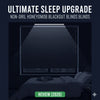Motorized vs Manual Roller Blinds: Which Investment Makes Sense
- by Giorgi Gogidze

The decision between motorized and manual roller blinds involves much more than simple convenience. While motorized blinds offer undeniable appeal with their push-button operation and smart home integration, manual blinds continue to provide reliable, cost-effective window control. Understanding the real-world benefits, costs, and considerations of each option helps you make an informed decision that aligns with your lifestyle, budget, and long-term goals.
[toc]
Manual Roller Blinds: The Reliable Standard
Simplicity and Reliability
Mechanical Advantage Manual roller blinds operate through simple, proven mechanisms that have functioned reliably for decades. Chain pulls, spring systems, and cord mechanisms rarely fail and are easily repaired when issues arise.
No Power Dependencies Manual blinds work regardless of power outages, electrical issues, or smart home system failures. This independence ensures your window treatments always function when needed.
Immediate Response Manual operation provides instant feedback and control. You can feel resistance, adjust tension, and make precise positioning adjustments that automated systems might struggle to achieve.
Cost Effectiveness
Lower Initial Investment Manual roller blinds typically cost 60-80% less than comparable motorized versions. This significant savings makes quality window treatments accessible to more homeowners.
Minimal Ongoing Costs Beyond occasional maintenance, manual blinds have virtually no operating costs. No electricity consumption, no battery replacements, and no software updates required.
Simplified Maintenance Fewer components mean fewer potential failure points. Manual blind maintenance usually involves basic cleaning and occasional lubrication of moving parts.
Motorized Roller Blinds: Modern Convenience
Operational Advantages
Effortless Control Motorized blinds eliminate the physical effort required to operate window treatments, particularly beneficial for large blinds, high windows, or individuals with mobility limitations.
Precise Positioning Quality motorized systems can position blinds to exact specifications, allowing for precise light control that's difficult to achieve consistently with manual operation.
Remote Access Control blinds from anywhere in the room or, with smart systems, from anywhere in the world through smartphone apps.
Smart Home Integration
Automated Scheduling Program blinds to open and close at specific times, adapting to daily routines and seasonal changes automatically.
Environmental Response Advanced systems can respond to light sensors, temperature changes, or weather conditions, optimizing comfort and energy efficiency without user intervention.
Voice Control Integration with smart home assistants allows hands-free operation through voice commands.
Practical Considerations for Daily Use
Convenience Factors
Multiple Window Management Motorized systems excel when controlling numerous blinds simultaneously. One button can adjust every blind in a room or throughout the entire home.
Hard-to-Reach Windows High windows, windows behind furniture, or windows in awkward locations become easily accessible with motorized operation.
Consistent Operation Motorized blinds provide uniform operation regardless of user strength, height, or mobility, ensuring consistent results every time.
Lifestyle Integration
Morning Routines Automated morning opening can replace alarm clocks with natural light, supporting healthy circadian rhythms.
Security Benefits Programmable operation creates the appearance of occupancy when you're away, enhancing home security through varied blind schedules.
Energy Management Automated responses to temperature and light conditions can reduce heating and cooling costs by optimizing natural light and heat gain.
Cost Analysis and Long-term Value
Initial Investment Comparison
Purchase Price Differential Motorized roller blinds typically cost 3-5 times more than manual equivalents, with the gap widening for smart-enabled systems with advanced features.
Installation Costs Motorized systems often require electrical work, adding to installation costs. Battery-powered options reduce this expense but introduce ongoing battery replacement costs.
Supporting Infrastructure Smart motorized systems may require hub purchases, professional setup, and integration services, further increasing initial costs.
Operating Cost Considerations
Energy Consumption Hardwired motorized blinds consume minimal electricity, typically adding less than $20 annually to electric bills for an average home.
Battery Replacement Battery-powered systems require periodic battery replacement, typically every 1-3 years depending on usage patterns and battery type.
Maintenance and Repairs Motorized systems have more complex mechanisms that may require professional service, with repair costs typically higher than manual blind maintenance.
Reliability and Longevity Factors
Manual System Durability
Proven Longevity Quality manual roller blinds can function reliably for 15-20 years with basic maintenance, providing excellent long-term value.
Repairable Components Most manual blind components can be repaired or replaced individually, extending the blind's useful life significantly.
Weather Independence Manual operation isn't affected by temperature extremes, humidity, or electrical fluctuations that can impact motorized systems.
Motorized System Considerations
Technology Evolution Smart home technology evolves rapidly, potentially making current systems obsolete within 5-10 years.
Component Complexity Motors, sensors, and control systems introduce multiple potential failure points that may require professional diagnosis and repair.
Software Dependencies App-controlled systems depend on ongoing software support from manufacturers, which may not be guaranteed long-term.
Specific Application Scenarios
When Manual Makes Sense
Budget-Conscious Projects For homeowners prioritizing cost-effectiveness, manual blinds provide excellent functionality at accessible prices.
Simple Window Configurations Single windows or small groups of windows don't typically justify the added complexity and cost of motorization.
Rental Properties Manual blinds offer lower initial costs and reduced complexity for rental property owners who prioritize reliable, low-maintenance solutions.
When Motorized Excels
Accessibility Needs Individuals with mobility limitations, arthritis, or other physical challenges benefit significantly from motorized operation.
Large or Numerous Windows Homes with many windows or very large blinds make motorized control practical and time-saving.
Smart Home Enthusiasts Homeowners investing in comprehensive home automation find motorized blinds a natural extension of their smart home ecosystem.
Technology Considerations
Control Options
Basic Remote Control Entry-level motorized systems offer simple remote control operation, providing convenience without smart home complexity.
Smart Home Integration Advanced systems integrate with major smart home platforms, enabling sophisticated automation and voice control.
Smartphone Apps Dedicated apps provide scheduling, scene control, and remote access capabilities that enhance the motorized blind experience.
Power Solutions
Hardwired Systems Permanent electrical connections provide reliable power but require professional installation and limit future flexibility.
Rechargeable Batteries Built-in rechargeable batteries offer installation flexibility with periodic recharging requirements.
Solar Options Some systems offer solar charging capabilities, reducing long-term operating costs while maintaining wireless installation benefits.
Making the Right Choice
Assessment Criteria
Usage Patterns Consider how often you adjust your blinds and whether automation would provide meaningful benefits for your lifestyle.
Physical Requirements Evaluate whether manual operation presents challenges based on window placement, blind size, or personal mobility considerations.
Budget Priorities Determine whether the convenience benefits justify the significant cost premium of motorized systems.
Future Planning
Home Integration Goals Consider your long-term smart home plans and whether motorized blinds fit into a broader automation strategy.
Resale Value Impact High-quality motorized blinds may enhance home value, particularly in luxury markets where automation is expected.
Technology Comfort Level Assess your comfort with technology maintenance and troubleshooting, as motorized systems require more technical management.
The Verdict
Both motorized and manual roller blinds have distinct advantages that make them suitable for different situations and priorities. Manual blinds excel in simplicity, reliability, and cost-effectiveness, making them ideal for straightforward applications and budget-conscious homeowners. Motorized blinds shine in convenience, automation, and accessibility, justifying their premium cost for users who value advanced functionality.
The best choice depends on your specific needs, budget, and lifestyle preferences. Consider starting with manual blinds for most windows and upgrading to motorized options for specific challenging applications or when budget allows. This hybrid approach lets you experience both technologies while optimizing cost and functionality.
Ultimately, both options can provide years of reliable service when properly selected and installed. Focus on quality components and professional installation regardless of which technology you choose, ensuring your investment delivers lasting value and satisfaction.







